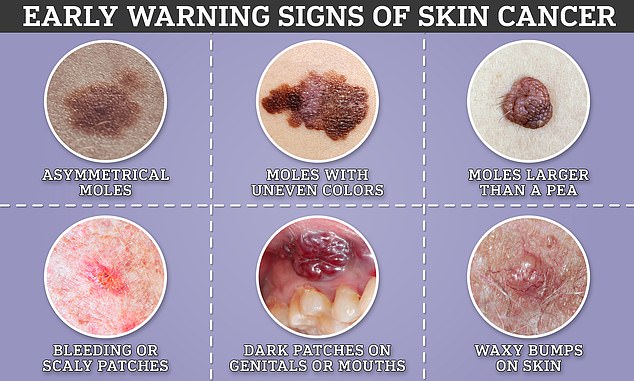A bodybuilder is urging people to get their moles checked after she was diagnosed with the deadliest form of skin cancer.
Kristina Angeli, who has been competing for over a decade, posted a video to Instagram showcasing the subtle sign that led to her needing ‘life changing surgery’.
Two years ago, the mother-of-one was preparing for a competition in the Bahamas when she became increasingly self-conscious of a mole close to her ear.
The fitness fanatic, from Canberra, Australia, decided to get the ‘ugly’ growth removed a few months after the competition for ‘vanity reasons’.
In the caption to the video, which has been viewed over 74,000 times, she wrote: ‘She doesn’t know it yet but that mole above her ear is cancer.’
‘When removing it, the doctor told me that it was risky as it was next to a major nerve’, she recalled.
‘I could lose all sensation to the left side of my face. That was only the beginning…’.
A few months later, it was discovered that the mole was actually melanoma—the deadliest form of skin cancer.
Ms Angeli was diagnosed with a stage 2 form of the disease meaning there was no evidence it had yet spread outside of the skin to other tissue.
She then underwent ‘surgery to remove the melanoma—but she said in another video posted to social media ‘didn’t go exactly as planned’.
Surgeons were forced to make a wide excision to remove the cancer as well as a removing lymph node from under her neck.
According to Cancer Research UK (CRUK), doctors usually recommend patients with the disease have a lymph node removed to test for cancer as a precaution.
Ms Angeli then was left with large portion of skin removed which medics covered up with a skin graft harvested from her left hip.
Recalling her ordeal she said: ‘This whole journey has been scary. But I’ve learnt and been reminded of so much.’
Two years on, she uses her platform to urge others to get their skin checked before it’s too late.
In her most recent post about her melanoma journey, she said: ‘I’m going for a skin check tomorrow. They always make me nervous. But it will mark two years cancer free.

Signs of skin cancer range from innocuous to obvious, but experts warn that treating cases early is key to making sure they do not spread or further develop
‘Get your skin checked.’
Most melanomas present as moles that have uneven edges and look different from ‘normal’ moles.
The Skin Cancer Foundation also warns people to look out for ‘ugly ducklings’—unsightly moles that very clearly stick out.
Size also matters when it comes to suspicious moles, with melanomas typically being around the size of a pea, or larger than 6millimetres in diameter.
Around 15 per cent of those diagnosed with stage two melanomas will not live beyond five years.
At stages three and four—when the disease has spread to nearby tissue, organs or bones—only 66 and 27 per cent of people will survive respectively.
Sun beds and sun exposure have been linked to a higher risk of developing melanoma.
It only takes being sunburnt five times in your life to increase the risk of the cancer that kills more than 2,000 people in the UK every year.
One in 41 women in the UK will be diagnosed with melanoma skin cancer in their lifetime.
An alarming 90 per cent of skin cancer cases in the UK are a direct result of sunburn and using sunbeds, according to CRUK, but those with a family history of the disease are at greater risk.
A common misconception is that melanoma only affects the skin on the face body, and limbs.
However, it can also develop on the palms, soles of the feet and even under the nails, as well as other areas vulnerable to sun damage such as the scalp.
To decrease the risk of developing skin cancer, experts advise applying sunscreen regularly, covering up as much as possible when outside and keeping babies and children out of the sun.
Healthcare professionals also advise people who are worried about a new mole or a mole that has changed shape or colour to contact their GP.
This article was originally published by a www.dailymail.co.uk . Read the Original article here. .

